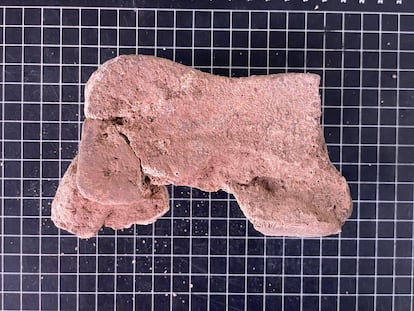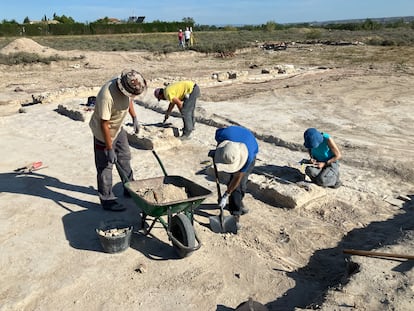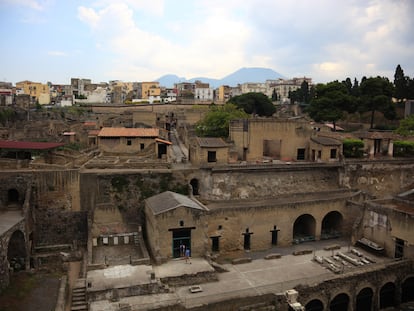A 2,000-year-old battle elephant bone was found in Spain. Experts are investigating whether the animal fought for Hannibal or Julius Caesar
Archaeologists also located 17 catapult ‘bullets’ and other weapons, as well as brooches, coins, and millstones from different periods


It is an enigma of mammoth proportions, which is why its discovery was kept under wraps for four years, until more information could be gathered. During an emergency excavation in Córdoba in 2019, archaeologists found a carpal (hand bone) of “an elephant of large proportions” killed between the end of the 4th century and the middle of the 1st century B.C. Its location, the hill of Los Quemados and its surroundings, in the heart of the southern Spanish city of Córdoba, was possibly the main theatre of a large-scale battle involving African elephants. In addition, 17 projectiles (fired by catapults) and other weapons have been located. The Roman Gaius Lucius Marcus took the city, which until then had been in Carthaginian hands, in 206 B.C., and in 45 B.C. Julius Caesar, who was protected by the elephants of the Mauretanian king Bogud, expelled the Pompeians during the Roman Republic’s second civil war. Therefore, the questions are: does the bone come from one of Hannibal’s war elephants or one of Julius Caesar’s? Or could it even be one of the pachyderms sent by the kings of North Africa to the siege of Numancia? Did the animal die in battle or due to another reason? The experts are not sure.
Rafael Martínez, the zoologist and assistant professor of prehistory at the University of Córdoba, has examined the bone and explains to EL PAÍS that it is a “carpal belonging to the right hand, a bone also known as capitatum, of an African or Indian elephant. It is very difficult to determine the species, whether Asian (Elephas maximus) or African (Loxodonta Africana). This discovery is of enormous interest given the practical absence of remains of elephants from a pre-Roman context in Europe, excluding ivory objects, of course.”
“In any case,” he continues, “this discreet bone can be interpreted as proof of the presence of these animals in the area of present-day Córdoba between the 4th and 2nd centuries B.C. The reason why it is so interesting is that it is not a tusk, which was raw material for making crafts, but a hand bone. It could belong to the period of the Punic Wars [between Carthaginians and Romans]. It could be the first of Hannibal’s elephants to be discovered. We can’t know for sure, but it was certainly a sizeable beast.”
Experts have not been able to perform a carbon-14 analysis to determine the date of the pachyderm’s death, because the bone fragment, measuring 15 by 8 centimeters, is not fossilized, but remains porous. Specialists, however, have saved a small sample for a possible protein analysis to obtain more information.
The story of the discovery begins in 2019, when the Amancio Ortega Foundation donated €40 million ($42.8 million) to provide Spanish hospitals with high-tech equipment. Three of the devices were destined for the Reina Sofía university hospital in Córdoba. But a problem arose. Since radiation is used in the treatments, a concrete bunker needed to be constructed to keep the effects of the equipment away from the other patients in the health center. The regional authorities approved the Spanish businessman’s donation and so, given the historical nature of the hill where the hospital stands, it approved emergency excavations.

Agustín López Jiménez, an expert from Arqueobética (the consultancy that carried out the archaeological research) explains that the place where the bone was found was “an important economic center of the Tartessian and later Turdetan culture.” And he explains how the discovery was made: “At the beginning of the intervention [dig] we documented structures from the Andalusian Emirate and Caliphate period [8th to 10th centuries]. Beneath them, remains emerged of collapsed adobe walls from the high Iberian period, around the 3rd century B.C. Under the one of these collapsed walls is where the carpal was located. In addition, we found 17 catapult ‘bullets’ (small artillery projectiles) and a spear tip (a spike that was used to stick the weapon into the ground). But we have no evidence that a battle or siege took place at the site, so the discovery of these war items was a surprise.” In addition, an oven made with adobe bricks, some coins, an Iberian millstone, Hispanic annular brooches and La Tène type brooches (4th century B.C.) were also found.
Fernando Quesada, a world-renowned expert on pre-Roman weapons, who also collaborated on the research, is not inclined toward either of the two options (Roman or Carthaginian elephant). “The contexts have not been made, and I have not seen the materials. It may be an elephant belonging to Hannibal or to Julius Caesar when he requested that King Bogud of Mauretania come to his aid at Montemayor [Córdoba] and possibly bring elephants. We do not know if the projectiles are associated with the animal, so I do not have a formed opinion. At this time it is impossible to determine.”
Quesada also cautions that the elephant could be an animal from the 1st or 3rd centuries A.D. “It could be a pachyderm from North Africa that joined the Carthaginian armies, but it could also be from 50 B.C., so the context would correspond to the Roman civil wars in Andalusia, when Julius Caesar came to Hispania. In that case, we would get into some confusing military campaigns that we are studying at the Montemayor site, just a day’s walk from Córdoba. That is, it could be an elephant brought by King Bogud, who came to help one of the sides in the battle. Caesar is directly involved in some of the campaigns, but in others he is not. We also know that in other battles, such as Numancia [133 B.C.], the kings of North Africa sent elephants to help, and they would have had to pass through Andalusia. It is too early to say.”
Córdoba is not the only place where the Carthaginians were able to use pachyderms. On the banks of the Tagus at Driebes (Spain), it was proven that Hannibal fought with 40 elephants to defeat the troops of the Carpetani, Vettones and Olcades tribes, who were much superior in number. But the Indigenous people did not take into account the genius of the invader, who placed his troops at the fords of the river — the only places where it could be crossed on foot — so the Carpetani had to concentrate their warriors at those places, and therefore lost their numerical advantage: a lot of troops, but too little space to fight.
To force them to cross, Hannibal built a palisade parallel to the riverbed. He placed the cavalry at the fords and the infantry and most of the elephants behind the palisade. When the Carpetani tried to cross the river, they died: swept away by the waters or killed by the Carthaginian horsemen, who were better supported by the river bed. Of the fifty African pachyderms that Hannibal had, 20 were donated to his brother Hasdrubal to maintain the war against the Romans in the Iberian Peninsula while he directed the rest of the animals toward the Pyrenees. For years, Emilio Gamo, director of Driebes research, has been conducting surveys in the Tagus in search of skeletal remains of the animals that entered battle. “At the moment, we have not been successful, because we have to cover a length of more than 10 kilometers of river. It is very difficult,” he says.
Between 48 and 45 B.C., Caesar’s troops fought around the city of Ulia (present-day Montemayor) against the legions of Pompey the Great and his sons Gnaeus and Sextus, in a period that is known as the Roman Republican Civil Wars. Caesar’s army was commanded by General Quintus Cassius Longinus. After multiple changes in fortune — both sides were Romans and had the same weapons and tactics — Cassius asked King Bogud for help, who had time to arrive with reinforcements, possibly with African elephants, says Quesada.
Whose army does the elephant’s hand found in the heart of the city of Córdoba belong to? For the moment, it is unknown. But at last there is proof that an ancient war elephant stood on the banks of the Guadalquivir, and it is kept discreetly in the warehouses of the Archaeological Museum of Córdoba.
Sign up for our weekly newsletter to get more English-language news coverage from EL PAÍS USA Edition
Tu suscripción se está usando en otro dispositivo
¿Quieres añadir otro usuario a tu suscripción?
Si continúas leyendo en este dispositivo, no se podrá leer en el otro.
FlechaTu suscripción se está usando en otro dispositivo y solo puedes acceder a EL PAÍS desde un dispositivo a la vez.
Si quieres compartir tu cuenta, cambia tu suscripción a la modalidad Premium, así podrás añadir otro usuario. Cada uno accederá con su propia cuenta de email, lo que os permitirá personalizar vuestra experiencia en EL PAÍS.
¿Tienes una suscripción de empresa? Accede aquí para contratar más cuentas.
En el caso de no saber quién está usando tu cuenta, te recomendamos cambiar tu contraseña aquí.
Si decides continuar compartiendo tu cuenta, este mensaje se mostrará en tu dispositivo y en el de la otra persona que está usando tu cuenta de forma indefinida, afectando a tu experiencia de lectura. Puedes consultar aquí los términos y condiciones de la suscripción digital.
More information
Archived In
Últimas noticias
Alain Aspect, Nobel laureate in physics: ‘Einstein was so smart that he would have had to recognize quantum entanglement’
Imelda Castro, the woman who wants to rule the cartel battleground of Sinaloa
The new victims of the Republican war on Obamacare: Millions hit by soaring health insurance premiums
A country divided on migrant rights: Some US states expand protections while others restrict them
Most viewed
- David King, chemist: ‘There are scientists studying how to cool the planet; nobody should stop these experiments from happening’
- Reinhard Genzel, Nobel laureate in physics: ‘One-minute videos will never give you the truth’
- Oona Chaplin: ‘I told James Cameron that I was living in a treehouse and starting a permaculture project with a friend’
- Sinaloa Cartel war is taking its toll on Los Chapitos
- Mexico completes its trade shift with the entry into force of tariffs on China and countries without trade agreements










































